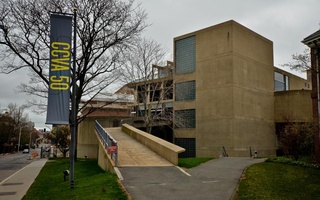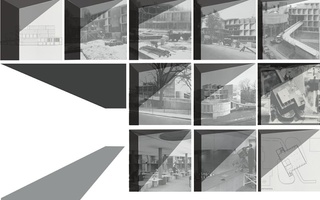“Circa 1963” in the Sert Gallery of the Carpenter Center for Visual Arts is a flashback to the time when architect Le Corbusier’s only building in the United States was a modern marvel. The exhibition showcases pieces from the early 1960s when the building first opened in the ‘60s. To some of us, the Carpenter Center might just be a concrete building across from Lamont, but its architectural and historical story has earned it a year of celebration leading up to the building’s 50th anniversary in May of 2013.
Wandering up the long ramp to the Sert Gallery, it is easy to see why the Carpenter Center is unique. The structure was built with the intention of being used as an art-making space and was designed in such a way that, because of the different entrances, rounded concrete, and large windows, a viewer can see the many studio spaces that the building has to offer of where he or she is.
“[Le Corbusier] was so excited that he was making an arts building that should inspire creative practice in use,” said David Rodowick, Director of the Carpenter Center and Department Head of Visual and Environmental Studies. The prospect of a building totally devoted to the arts was also exciting for Nathan Marsh Pusey, the president of Harvard at the time of construction.
“President Pusey wanted to make a big splash,” said Rodowick. He began working with Josep Lluis Sert, a Spanish architect who was then Dean of the Graduate School of Design. “Sert said that Le Corbusier is it. He lobbied for the building because he was friends with Le Corbusier, who was then at the end of his career and his life,” said Rodowick. With a generous gift from the Carpenter family, plans were set in place for the building, and in 1960 Le Corbusier came to America to present his model.
“There was certainly a big controversy about having this modernist icon amongst the [Harvard] Faculty Club and the red bricks,” said Rodowick. “[Le Corbusier] knew that this would be his only major building in North America, so he was essentially given carte blanche.” The Carpenter Center’s architecture is not the only feature that separates it from the traditional buildings in Harvard Square. “The building is special not only because it is unique but because it is an art building,” said Rodowick. “It was meant to be an artistic capstone to his career.”
“Le Corbusier wanted to make a restatement of basic architectural ideas… all elements in the building are drawn from other innovations of his. There is a flow of air, light, and movement throughout the building, which makes all different practices intersect.”
This cohesion is also found in the exhibition, “Circa 1963.” Moving into the installation room, one can’t help but notice how the pieces themselves engage in an artistic dialogue. The exhibition boasts an eclectic mix of pieces that at first glance seem to conflict with each other. For example, a large George Sugarman sculpture in the middle of the room stands in stark contrast to the Yoko Ono found-objects piece. This difference in artistic mediums and themes is one of the more important aspects of the collection. “There is a unity in design, in experimentation. There is the question of, ‘What is a medium?’ This is very prevalent today,” Rodowick said.
Choosing the pieces for the show was no easy task. Rodowick, the driving force behind “Circa,” gave himself the boundaries of finding pieces from between the years 1960 to 1965, the time period surrounding the opening of the Carpenter Center in 1963. Rodowick tried to select a wide variety of pieces that would work well in conjuction with each other. The selected pieces were originally located at the Fogg Collection and the Addison Gallery of American Art of Phillips Academy.
According to Rodowick, public reception of “Circa 1963” has been positive so far. “The exhibit’s only been open a week but there’s already been a lot of traffic,” Rodowick said. Pedra Hodgson, architectural critic at the Zurich University of Applied Sciences, happened to stumble across the exhibition while exploring the building itself, specifically some “old friends,” (like a couple of Aaron Siskind photo prints). She thought that the pieces in “Circa 1963” seemed to work suitably together and were representative of the time period. “The pluralism and different ways of expression at the time are shown here, what with the straightforward abstract [pieces] but also in the paintings.”
Ultimately, the Carpenter Center and “Circa” bring togehter different works of art to emphasize the historic importance of the building and the ways in which it continues to remain relevant. According to Rodowick, Le Corbusier always said that his buildings should bring together head and heart. The Carpenter Center aims to fulfill the vision of its creator through its programming during this anniversary year of its completion and the continued devotion to the art community.
—Staff writer Anneli L. Tostar can be reached annelitostar@college.harvard.edu.
Read more in Arts
Portrait of An Artist: Liv A. RedpathRecommended Articles
-
‘Say You Love Me’ Challenges Depiction of DesireSexual predation. Innocence. Power. These are some of the themes explored by provocative photographer and video artist Laurel Nakadate in ...
-
Artist's Exhibit Honors Carpenter CenterAs an undergraduate studying Visual and Environmental Studies, Matt R. Saunders ’97 spent his evenings in the Harvard Film Archive in the basement of the Carpenter Center. Now a visiting lecturer in the department, Saunders’s work has become part of a celebration of the building’s 50th anniversary with an exhibition there of his own.
-
 A Modern Moment
A Modern Moment -
 Fifty Years Old, And Still A Campus Art Hub
Fifty Years Old, And Still A Campus Art Hub













